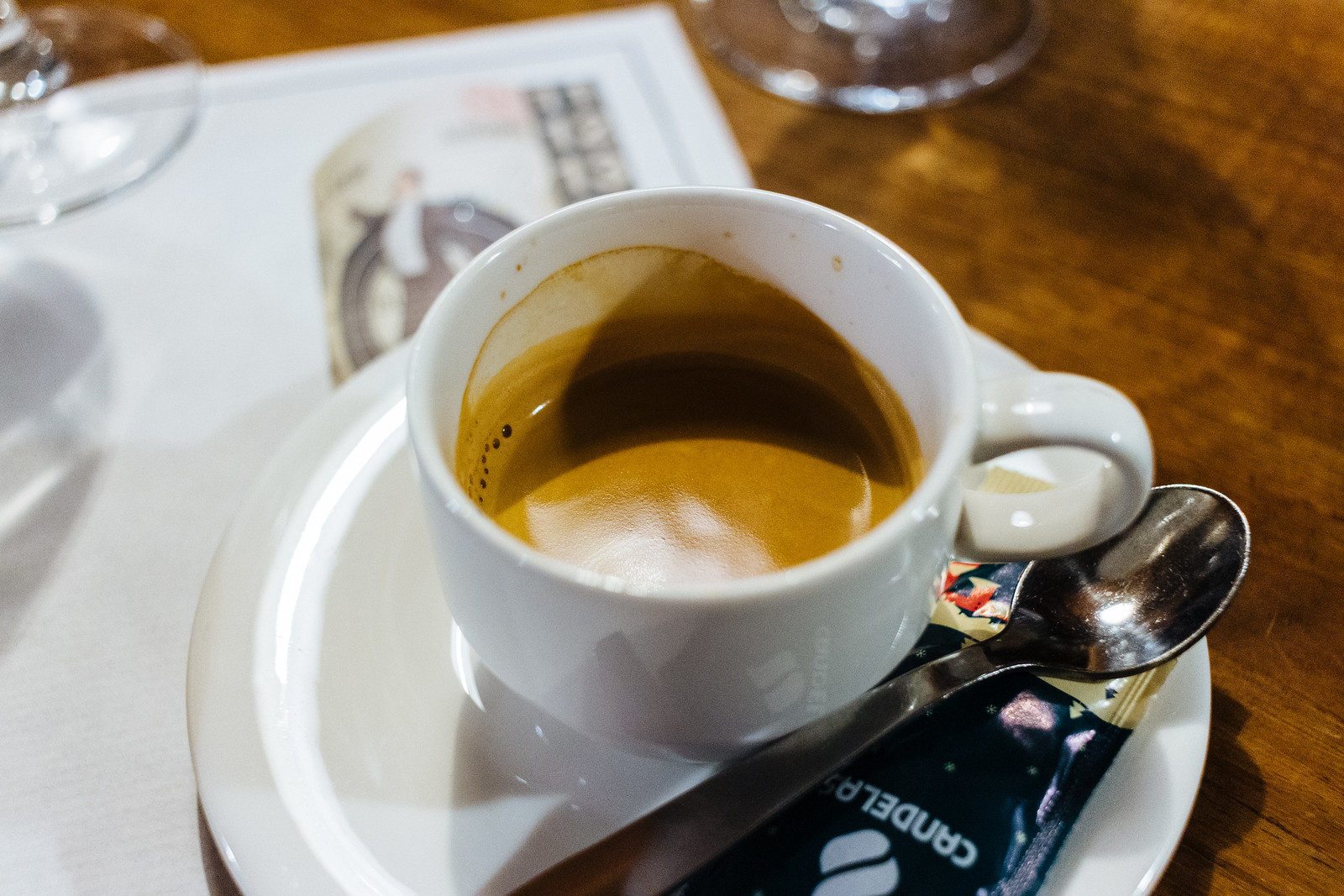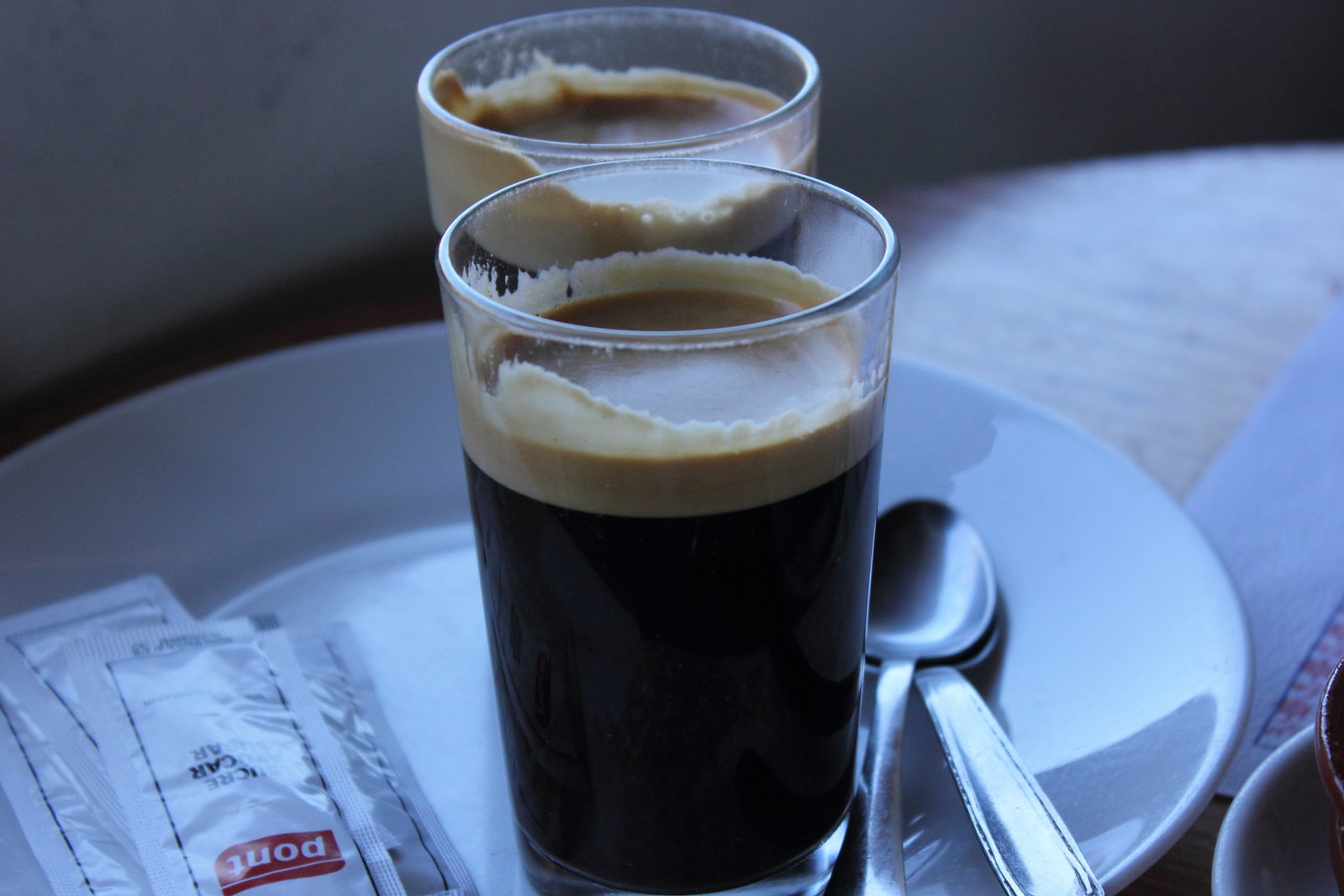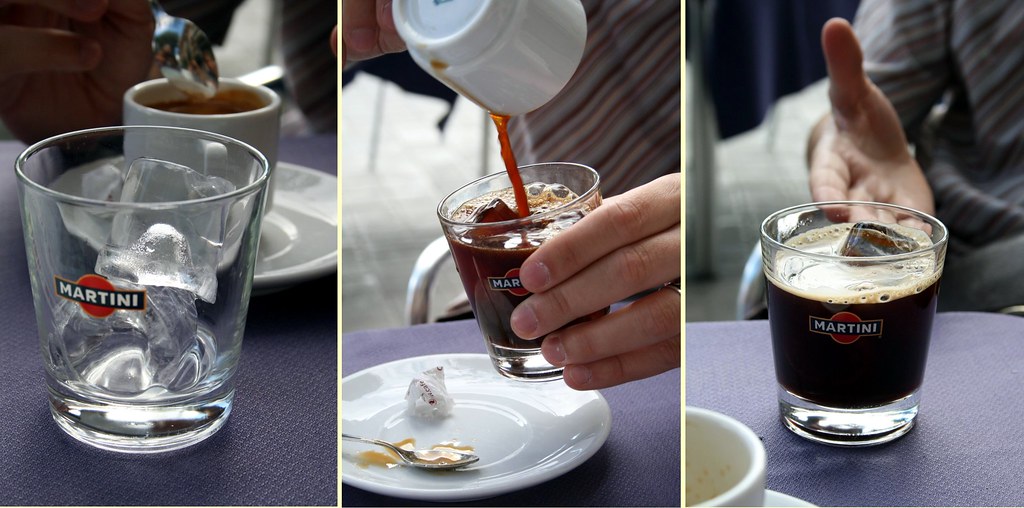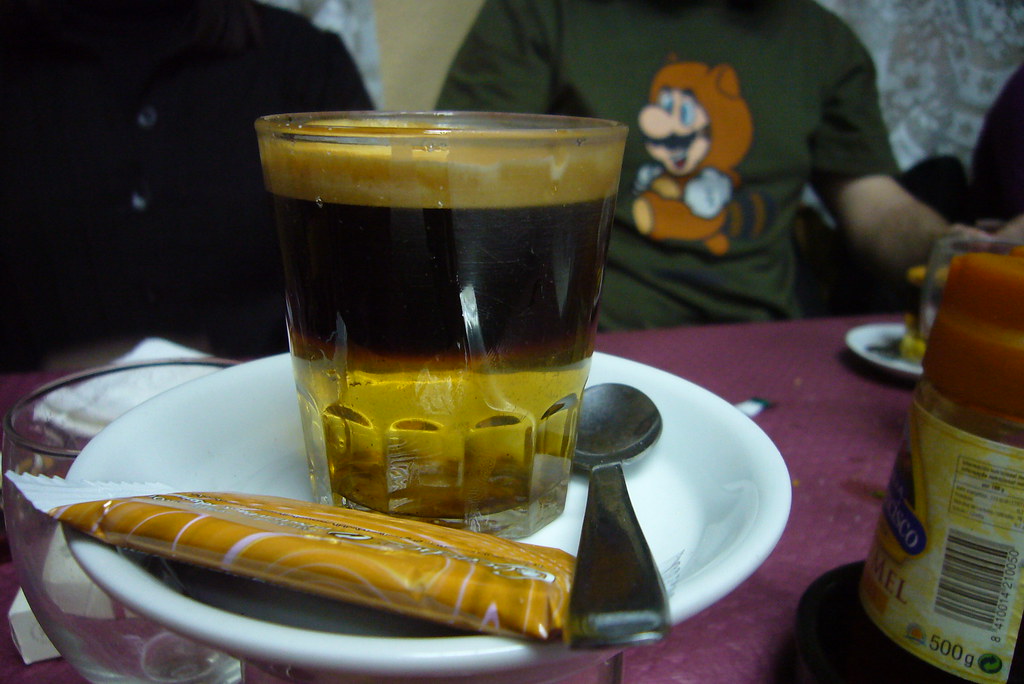How to Drink Coffee in Spain: 8 Ways to Order a Cup of Joe
Confession: I’m not that big of a coffee drinker—tea is really more my thing. But I do enjoy the occasional cuppa joe about once a week, and after living here in Spain for a year, I’ve figured out how to add some variety to my morning injection of caffeine beyond the standard café con leche. Most of these are just variations on a shot of espresso and steamed milk, but there are a few surprises, too. Get your coffee pot started and join me as I explain the basics of drinking coffee in Spain.
“Coffee alone” is simply a shot of espresso, the coffee beverage that is made from forcing hot water at a high pressure through ground coffee beans. It’s served in a short, tiny glass or ceramic cup with a saucer, spoon, and a bag of sugar. A good café solo will have a thick, almost bitter body capped with thin layer of foam. This is coffee at its purest.
A café cortado is called so because the shot of espresso is “cut” with some steamed milk—but only some, as there’s more coffee than milk in this drink. It’s not quite as strong or bitter as a straight-up café solo; instead, the creaminess of the milk makes it a little more palatable. Author David Lebovitz, who writes about pastries in France, has praised the simple pleasures of the cortado in a really lovely blog post.
Love, love, love me some café con leche. Equal parts espresso and steamed milk, this is the best of both worlds, and the milk foam is literally the icing on the cake. Compared with other beverages on this post, a café con leche is actually quite substantial in terms of volume, so it will last you longer if you’re having breakfast or munching on a snack. Although I know I’m not terribly original at all, this is my favorite on this list because, for me, it’s the perfect combination of coffee bean and dairy. What I really love, however, is the contrast between the cooling milk foam on top and the hot coffee beneath.
This drink is sometimes called a café manchado (literally a “stained coffee”), which is a bit of a misnomer, implying it’s a shot of espresso that has been stained with milk—which would in reality make it a cortado.
Instead, try ordering a leche manchada (“stained milk”): mostly steamed milk with a little bit of espresso, not quite an entire shot. Very milky with a little coffee flavor, this is for you folks who like to drink coffee but don’t actually like coffee.
(In the picture above, a café con leche is in the foreground and a manchada is in the background.)
Don’t confuse “American coffee” with drip or filter coffee; to create a café americano, you add hot water to a shot of espresso…and that’s it! Starbucks’ website describes this drink as “a coffee that satisfies the American preference for more sips in every cup,” and although an americano hardly sizes up to the cavernous mugs of coffee most Americans are accustomed to, I’d say this hits the spot when you’re craving some black coffee but aren’t in the mood for a brief, concentrated café solo.
Add a shot of espresso (café solo) to a glass of ice cubes and you get café con hielo—“coffee with ice.” Although it hardly measures up to your typical grande iced coffee to-go from Starbucks, it’s a nice pick-me-up that Spaniards often drink on warm summer afternoons when they’re craving some caffeine but don’t want something too hot. You’ve got to be fast when pouring the espresso into the glass of ice, though, otherwise you’ll end up with a mesa con café, a “table with coffee”! My friend Alissa has written a great, introspective post about the deeper meaning behind the flick of the wrist involved in making a café con hielo here.
Pronounced “kah-rah-KHEE-yoe” [ca.ɾaˈxi.ʎo], this coffee-based drink might throw you for a loop since it’s one part brandy and another part espresso. Yep—alcohol and caffeine sound like a risky combination, but it’s surprisingly common in the afternoon and evening. Fun fact: a carajillo with whipped cream on top becomes a café irlandés: an Irish coffee.
Yep, this is what you’re thinking it is: a “bonbon coffee.” Add one part condensed milk to one part espresso and you’ve got a café bombón, a syrupy and sweet little shot that tastes like the gooey inside of a chocolate bonbon. It’s basically liquid candy. But to be fair, I really am in love with the presentation here: the condensed milk sharply contrasts with the espresso that floats on top of it, so much so that when it’s all served in a clear glass you can see three stripes of milk, espresso, and foam. This makes for a great dessert coffee after a heavy menú del día.
#ProTip: to get any of these decaf, ask for it descafeinado, but make sure to add de máquina (“from the [espresso] machine”) because otherwise you might get instant coffee.
Final note: I am hugely indebted to this flowchart entitled Café para todos—Coffee for Everybody—that was put together by a Spanish blogger a couple years ago. I once wandered in the desert of Spanish cafeterías, but now I feel like a pro. Check it out!
How do you drink your coffee in Spain? Are these called by other names in different regions of Spain or Spanish-speaking countries? Write a comment below!
Café solo
 |
| Coffee at O Dezaséis in Santiago de Compostela |
“Coffee alone” is simply a shot of espresso, the coffee beverage that is made from forcing hot water at a high pressure through ground coffee beans. It’s served in a short, tiny glass or ceramic cup with a saucer, spoon, and a bag of sugar. A good café solo will have a thick, almost bitter body capped with thin layer of foam. This is coffee at its purest.
Café cortado
 |
| (Source: Alexandra Guerson) |
A café cortado is called so because the shot of espresso is “cut” with some steamed milk—but only some, as there’s more coffee than milk in this drink. It’s not quite as strong or bitter as a straight-up café solo; instead, the creaminess of the milk makes it a little more palatable. Author David Lebovitz, who writes about pastries in France, has praised the simple pleasures of the cortado in a really lovely blog post.
Café con leche
 |
| Coffee at Café Venecia in Santiago de Compostela |
Love, love, love me some café con leche. Equal parts espresso and steamed milk, this is the best of both worlds, and the milk foam is literally the icing on the cake. Compared with other beverages on this post, a café con leche is actually quite substantial in terms of volume, so it will last you longer if you’re having breakfast or munching on a snack. Although I know I’m not terribly original at all, this is my favorite on this list because, for me, it’s the perfect combination of coffee bean and dairy. What I really love, however, is the contrast between the cooling milk foam on top and the hot coffee beneath.
Una manchada
 |
| (Source: Miguel Librero) |
This drink is sometimes called a café manchado (literally a “stained coffee”), which is a bit of a misnomer, implying it’s a shot of espresso that has been stained with milk—which would in reality make it a cortado.
Instead, try ordering a leche manchada (“stained milk”): mostly steamed milk with a little bit of espresso, not quite an entire shot. Very milky with a little coffee flavor, this is for you folks who like to drink coffee but don’t actually like coffee.
(In the picture above, a café con leche is in the foreground and a manchada is in the background.)
Café americano
 |
| (Source: Arneliese) |
Don’t confuse “American coffee” with drip or filter coffee; to create a café americano, you add hot water to a shot of espresso…and that’s it! Starbucks’ website describes this drink as “a coffee that satisfies the American preference for more sips in every cup,” and although an americano hardly sizes up to the cavernous mugs of coffee most Americans are accustomed to, I’d say this hits the spot when you’re craving some black coffee but aren’t in the mood for a brief, concentrated café solo.
Café con hielo
 |
| (Source: Marion Deveaud) |
Add a shot of espresso (café solo) to a glass of ice cubes and you get café con hielo—“coffee with ice.” Although it hardly measures up to your typical grande iced coffee to-go from Starbucks, it’s a nice pick-me-up that Spaniards often drink on warm summer afternoons when they’re craving some caffeine but don’t want something too hot. You’ve got to be fast when pouring the espresso into the glass of ice, though, otherwise you’ll end up with a mesa con café, a “table with coffee”! My friend Alissa has written a great, introspective post about the deeper meaning behind the flick of the wrist involved in making a café con hielo here.
Carajillo
 |
| (Source: Carles Escrig i Royo) |
Pronounced “kah-rah-KHEE-yoe” [ca.ɾaˈxi.ʎo], this coffee-based drink might throw you for a loop since it’s one part brandy and another part espresso. Yep—alcohol and caffeine sound like a risky combination, but it’s surprisingly common in the afternoon and evening. Fun fact: a carajillo with whipped cream on top becomes a café irlandés: an Irish coffee.
Café bombón
 |
| Coffee at Restaurante Cantalejo in Madrid |
Yep, this is what you’re thinking it is: a “bonbon coffee.” Add one part condensed milk to one part espresso and you’ve got a café bombón, a syrupy and sweet little shot that tastes like the gooey inside of a chocolate bonbon. It’s basically liquid candy. But to be fair, I really am in love with the presentation here: the condensed milk sharply contrasts with the espresso that floats on top of it, so much so that when it’s all served in a clear glass you can see three stripes of milk, espresso, and foam. This makes for a great dessert coffee after a heavy menú del día.
#ProTip: to get any of these decaf, ask for it descafeinado, but make sure to add de máquina (“from the [espresso] machine”) because otherwise you might get instant coffee.
Final note: I am hugely indebted to this flowchart entitled Café para todos—Coffee for Everybody—that was put together by a Spanish blogger a couple years ago. I once wandered in the desert of Spanish cafeterías, but now I feel like a pro. Check it out!
 |
| (Source: copépodo) |
How do you drink your coffee in Spain? Are these called by other names in different regions of Spain or Spanish-speaking countries? Write a comment below!